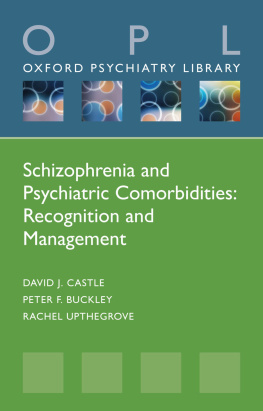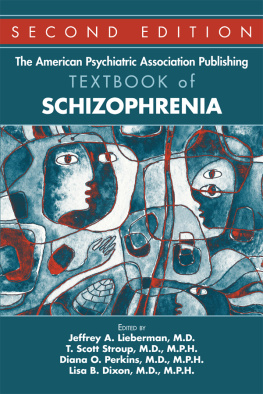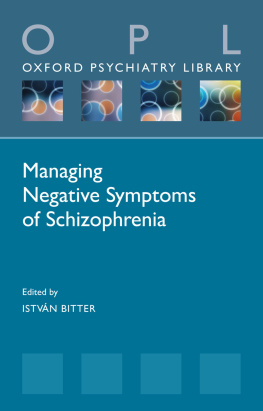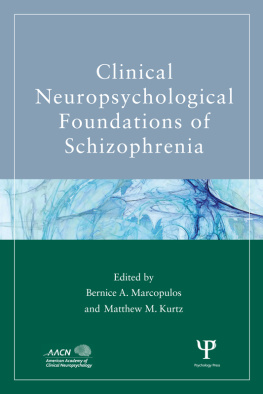O P L
OXFORD PSYCHIATRY LIBRARY
Schizophrenia and Psychiatric Comorbidities

Great Clarendon Street, Oxford, OX2 6DP,
United Kingdom
Oxford University Press is a department of the University of Oxford.
It furthers the Universitys objective of excellence in research, scholarship, and education by publishing worldwide. Oxford is a registered trade mark of Oxford University Press in the UK and in certain other countries
Oxford University Press 2021
The moral rights of the authors have been asserted
First Edition published in 2021
Impression: 1
All rights reserved. No part of this publication may be reproduced, stored in a retrieval system, or transmitted, in any form or by any means, without the prior permission in writing of Oxford University Press, or as expressly permitted by law, by licence or under terms agreed with the appropriate reprographics rights organization. Enquiries concerning reproduction outside the scope of the above should be sent to the Rights Department, Oxford University Press, at the address above
You must not circulate this work in any other form and you must impose this same condition on any acquirer
Published in the United States of America by Oxford University Press
198 Madison Avenue, New York, NY 10016, United States of America
British Library Cataloguing in Publication Data
Data available
Library of Congress Control Number: 2020948005
ISBN 9780198870333
DOI: 10.1093/med/9780198870333.001.0001
Oxford University Press makes no representation, express or implied, that the drug dosages in this book are correct. Readers must therefore always check the product information and clinical procedures with the most up-to-date published product information and data sheets provided by the manufacturers and the most recent codes of conduct and safety regulations. The authors and the publishers do not accept responsibility or legal liability for any errors in the text or for the misuse or misapplication of material in this work. Except where otherwise stated, drug dosages and recommendations are for the non-pregnant adult who is not breast-feeding
Links to third party websites are provided by Oxford in good faith and for information only. Oxford disclaims any responsibility for the materials contained in any third party website referenced in this work.
Foreword
This scholarly volume is a very timely and welcome contribution to our field. It addresses and dissects the clinically critical issue of multiple comorbidities in schizophrenia. In addition, it integrates and synthesizes many lines of evidence for the extensive aetiological and clinical overlap among major psychiatric conditions that are currently regarded as free-standing DSM diagnostic categories. The implications for this scholarly scientific review and discourse should ultimately lead to a paradigm shift in conceptualizing the nosology, epidemiology, aetiology, and treatment of major psychiatric disorders including schizophrenia, depression, autism spectrum disorder, attention deficit hyperactivity disorder (ADHD), anxiety, OCD, PTSD and substance use.
For a long time, and prior to the neuroscience revolution that enabled probing the human brain and exploring the neurobiology of psychiatric disorders, the field of psychiatry was descriptive and simplistic. It categorized psychiatric disorders essentially as silos, defined by a set of signs and symptoms. If one or more psychiatric conditions co-occurred with a primary diagnosis, they were labelled as comorbidities, with no implications of a shared aetiology or biology. Amazingly, despite the rapid accrual of evidence of shared developmental or genetic aetiopathogenesis, dysplasia of the same brain regions on neuroimaging and a shared benefit from the same class of medications, DSM-5 and its traditional out-date schema, remains the diagnostic Bible of Psychiatry.
This archaic model is ripe for change.
The following are highlights of recent advances in re-conceptualizing the nosology of schizophrenia and other DSM diagnostic entities re-interpreting the comorbidities as evidence of the substantial clinical and biological overlap and inter-connectivity of psychiatric brain disorders.
Neurodevelopmental Pathology: Disruption of brain development during fetal life has been well established across the schizophrenia syndrome and practically all the so-called comorbidities (Beauchaine et al. 2018; Huttunen and Mednick 2018; Krueger and Eaton 2015).
Genetic Pleiotropy: About 50% of the 22,000 protein-coding genes in the human chromosomes are expressed in the brain during development. Schizophrenia and most psychiatric disorders are heavily genetic. Genetic pleiotropy has been identified across several psychiatric syndromes (Nasrallah 2013; Smoller and Cross-Disorder Group of the Psychiatric Genomics Consortium 2019). For example, the calcium channel A1 gene is shared by schizophrenia, autism, bipolar disorder, major depression and ADHD (Gudmundsson et al. 2019). This indicates that the DSM separation of those disorders is artificial and based on specific symptoms without integrating what is regarded as comorbid conditions into a unified model. Copy number variants have also been found in schizophrenia, ADHD, and autism spectrum disorders (Doernberg and Hollender 2016; Smoller and Cross-Disorder Group of the Psychiatric Genomics Consortium 2019).
Neuroimaging Concordance: Three brain regionsthe dorsal anterior cingulate, left insula, and right insulahave been reported to be abnormal across schizophrenia, bipolar disorder, major depression, OCD and anxiety. Those shared brain structural abnormalities are associated with various degrees of hypoplasia or atrophy (Goodkind 2015).
Intermediate phenotypes have been redefined to accommodate transdiagnostic vulnerabilities and aetiological complexity (Etkin and Cuthbert 2014; Beauchaine and Constantino 2017; Hyman 2019).
Shared symptoms have long been observed across various psychiatric disorders, including delusions, hallucinations, depression, anxiety, impulsivity, and autistic and cognitive symptoms (Kessler et al. 2011; Nasrallah 2017, 2019; Grisanzio et al. 2018).
Response to Pharmacotherapy: It is well recognized that the same class of psychotropic medications exert therapeutic efficacy across a variety of DSM disorders (Maher and Theodore 2012). The SSRIs and atypical antipsychotic exert efficacy in many psychiatric disorders beyond their original indication, which was approved by the FDA based on a specific DSM diagnosis.
Connectomics and neural circuits are now regarded as the neurobiological underpinnings of schizophrenia and other psychiatric disorders, and that may be a key reason for the transdiagnostic overlap (Elliott et al. 2018; Xia et al. 2018; Marshal 2020).
Similar neurobiological pathologies have been found to exist in several major psychiatric disorders including neuro-progression, white matter pathology, neuroinflammation, oxidative stress, mitochondrial dysfunction, glutamate pathways disruptions and shortened telomeres (Nasrallah 2017).
Familial Clustering: Various psychiatric disorders have been found to have significantly increased odds ratios (OR) among the first-degree relatives of patients with schizophrenia including bipolar 1 (4.27), bulimia (3.81), GAD (3.49), separation anxiety (3.10), drug abuse (2.83), conduct disorder (2.53), dysphasia (2.51), PTSD (2.30), alcohol abuse (2.27), major depression (2.18) and social phobia (2.0) (Plana-Ripoll et al. 2019).











